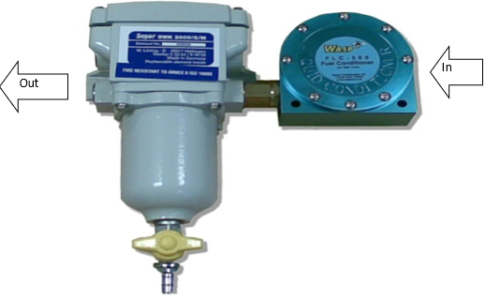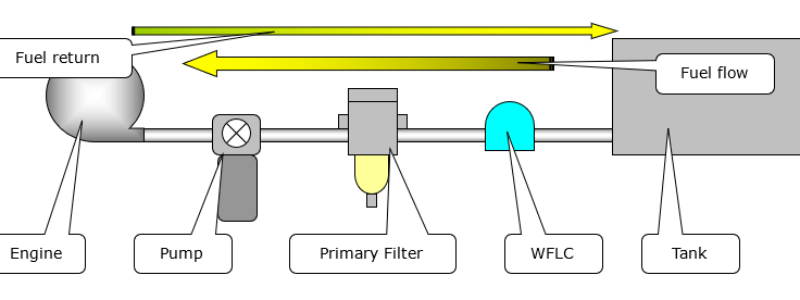Fuel conditioning units
section-87642a0
A breakdown can be mechanical, electrical or biological; how you prepare for each will dictate how your system performs over the coming years.
In any engine, it is common knowledge that oil and water should be checked and changed periodically. Likewise annual services maintain the performance and ensure issues are found before they can cause costly breakdowns.
Yet who prevents the biological attack? Some use biocides in their fuel, yet these are harmful to humans and must be handled with care, moreover whist they can be efficient at killing live bacteria, they do not remove the causes of the issue and can also be harmful to the rubber gaskets/seals in the engine system; degrading them and causing leaks. Finally, such biocides can harm the fuel itself, causing sediment to form through oxidization. However, there is a safe and clean alternative to such treatments.
In any diesel system (gas oil, MDO, fuel oil or any middle distillate fuel), a large proportion of the fuel pulled from the storage tank – be it in a generator, marine vessel, large vehicle, earthmoving equipment, railway locomotive etc. is used for cooling. This fuel is re-circulated around the engine and returned to the storage tank. This recirculation along with the use of a fuel filter/water separator is the key to the effectiveness of the W-FLC range.

The W-FLC should be installed in the fuel line before the main filter/water separator as in the example below.

W-FLC-500 unit installed with a SEPAR SWK2000/5M fuel filter/water separator
By installing in this way, the unit can literally condition the fuel in advance of its cleaning process. The effect of the W-FLC is to neutralize the live bacterial content of the fuel – stopping it from multiplying, and to increase the effectiveness of the water separator allowing it to trap more of the biomass; thus protecting the serviceable parts of the filter and meaning fewer replacement filter elements are needed.
Electron microscope images of such filter elements highlight the efficiency of these devices. The two images (right) show filter elements magnified 90 times. The same contaminated fuel was passed through both at the same time using the same pump. Before one, was an active conditioning unit, before the other was an identical conditioning unit which was not active.
As can be seen, the active unit protected the filter element as more contaminate/biomass was simply drained from the unit via the water separation stage, the un-activated unit clogged its filter element rapidly. You can find more detail on this experiment on the following page.
A WASP FLC device will protect your engine from fuel related breakdowns, neutralizing bacterial content and aiding the effective removal of sludge and other biomass by your existing fuel filter/water separator.

section-e71c96c
Fuel conditioning is vital for a clean running engine. Clean fuel means fewer emissions (smoke), more efficiency and fewer engine breakdowns. Follow this simple guide to ensure correct installation and you will find the WFLC enhances your fuel system and its reliability.
WASP FLC fuel conditioners are bidirectional, in other words there is no specific input and output port. Fuel can flow in either direction, so installation is straight forward enough, however the rounded section of the unit’s body must always be pointing upwards or sideways. We prefer straight connections, and do not recommend 90 o fittings. The WASP FLC is designed to be installed on the suction side of the pump, just before the primary filter.

section-ac383b7

installing the WFLC, we recommend using a qualified engineer or company, however as long as the correct procedures are followed and the installer complies with all applicable safety procedures the installation process is simple and straightforward.
As the WFLC can be used for middle distillate fuel, and if working around diesel or similar, extinguish all naked flames or other sources of ignition and ensure adequate ventilation in the area of installation. We strongly recommend the use of safety glasses and fuel resistant gloves. DO NOT mount the WFLC near to navigational equipment or devices sensitive to magnetic fields.
Ensure the engine or pumps which could affect the unit are switched off and the fuel or liquid supply is isolated. Ideally full flow ball valves should be installed before and after the unit to allow for complete isolation for installation. Install the WFLC unit using fittings and pipe/hose line of appropriate diameter, material and quality as recommended by your engine or machine manufacturer. Apply fuel resistant sealant to all connectors, we do not recommend Teflon tape (PTFE or similar) as fuel can cause pieces of the Teflon tape to break off and flow into the fuel system. We recommend using a pliable, non-hardening, diesel fuel resistant paste or gasket forming sealant.
We recommend using a mounting bracket (non ferrous) – do not use steel due to the magnetic properties of the WFLC. The units can be directly bolted to a surface assuming
there are no vibrations to worry about. If in doubt, use anti-vibration mounts. Ensure all connections / fittings are tight, open any ball valves and use the air bleed on the primary filter or pump to bleed the system. Check for any leaks and remedy as appropriate; the WFLC has now been successfully installed.
section-3ae687f
Get a Quote
Use this form to get a competitive quote!
How Does It Work?
Check out our interactive WASP Fuel Polishing System
Which Fuel Polishing System?
Try our interactive product selector